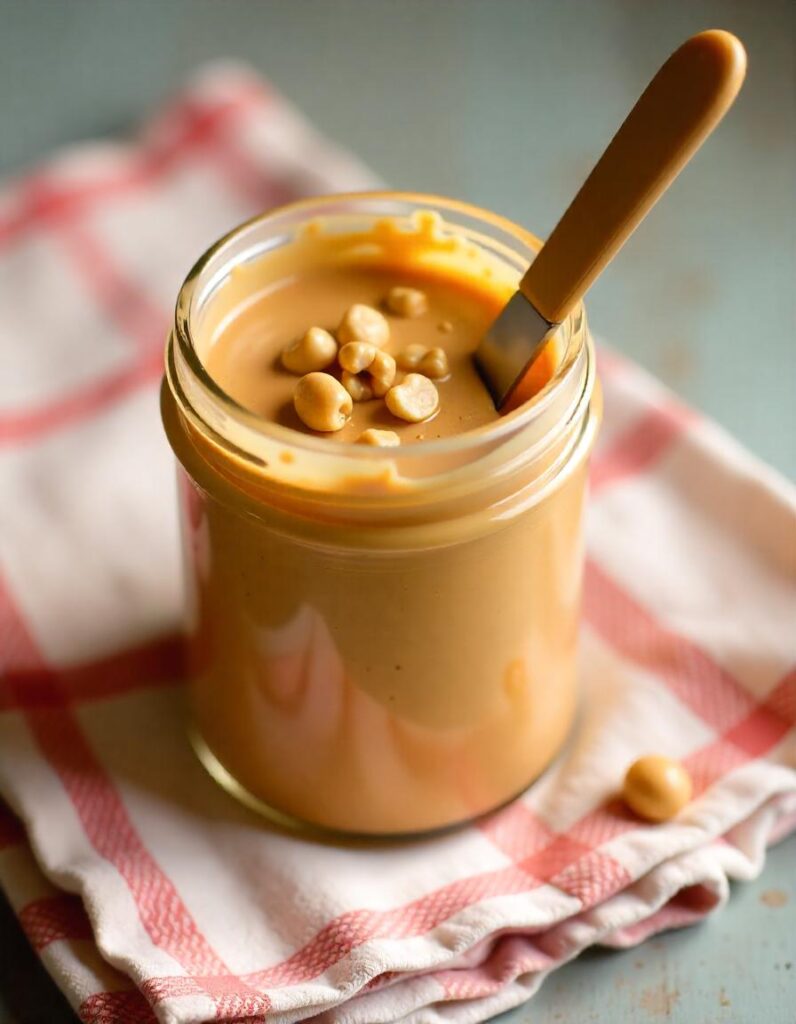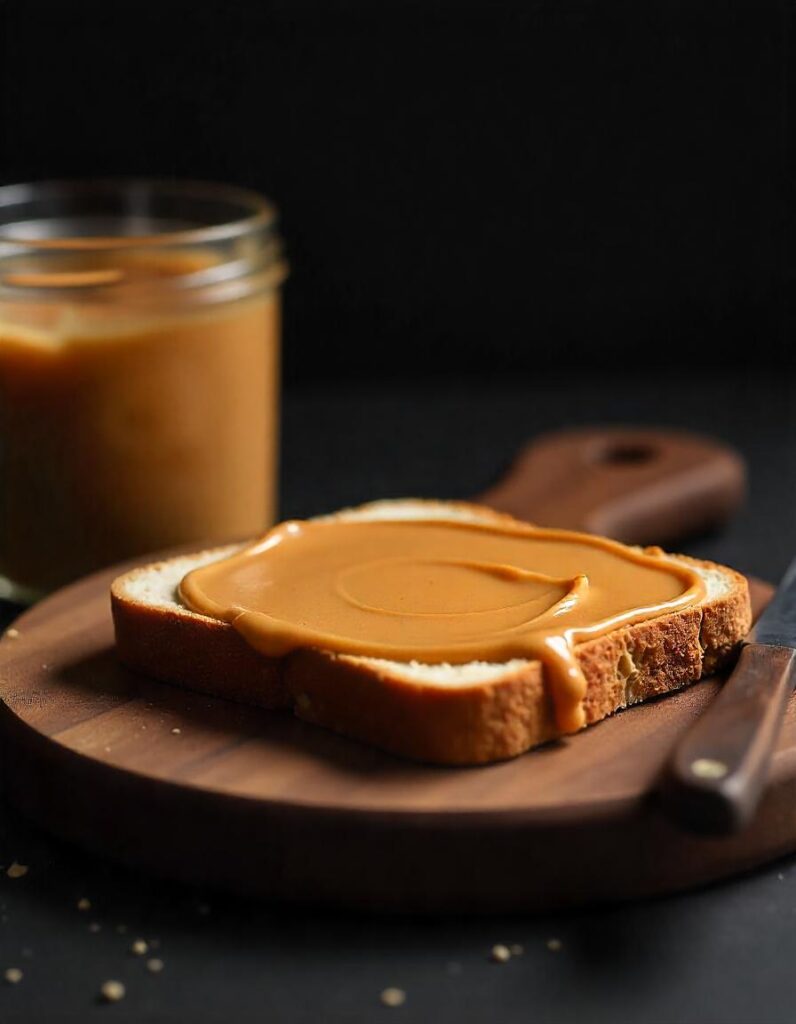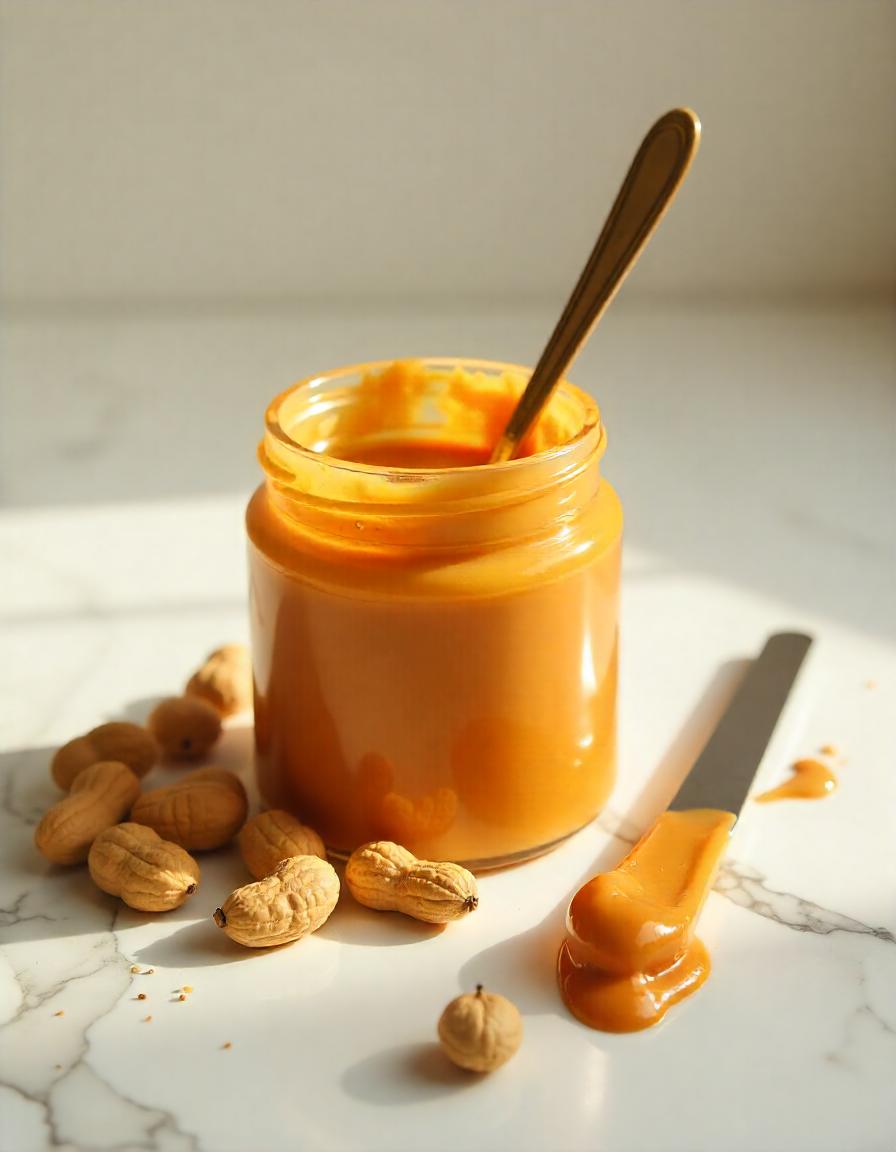Peanut butter is one of those pantry staples that just seems to last forever. Whether it’s slathered on toast, added to smoothies, or paired with jelly for the classic PB&J sandwich, it’s something almost everyone has enjoyed at some point. But have you ever wondered just how this creamy (or crunchy) delight has come to occupy such a prominent place in our hearts and kitchens? Well, you’re in for a treat!
In this article, we’re going to dive deep into the world of peanut butter. From its rich history and nutritional profile to its surprising health benefits, you’ll come away with a whole new appreciation for this spread. Plus, we’ll explore some common problems, like separation and allergies, and share tips on how to choose the best jar. So, whether you’re a peanut butter connoisseur or just someone looking for a little more info on this delicious spread, keep reading!
Table of Contents
What is Peanut Butter?
At its core, peanut butter is simply a paste made from ground dry-roasted peanuts. This creamy, slightly sweet, and often salty spread is made by grinding peanuts until they break down into a smooth consistency. But there’s more to it than just peanuts. Depending on the brand and variety, it may contain added oils, salt, sugar, and other ingredients to enhance flavor and texture.
There are a few variations of peanut butter out there, including creamy, chunky, and natural. While creamy butter is smooth and spreadable, chunky butter contains larger pieces of peanuts for added texture. Natural butter, on the other hand, usually has fewer ingredients, with just peanuts and maybe a pinch of salt. But no matter the variety, it remains a favorite for its rich taste and versatility.
The History and Evolution
Did you know that peanut butter has been around for centuries? Its roots can be traced back to ancient civilizations that used ground peanuts for various purposes. However, it wasn’t until the late 19th century that peanut butter, as we know it today, came into existence.
The modern-day version of peanut butter was patented by Dr. John Harvey Kellogg (yes, the same Kellogg behind the cereal) in 1895. Dr. Kellogg’s version was intended as a nutritious, vegetarian protein substitute for people who had difficulty chewing meat. The spread gained popularity in the early 20th century, especially after being promoted as a health food.
As the years passed, it evolved into the delicious spread we know and love today. Commercial production skyrocketed in the 1920s and 1930s, and soon enough, it became a household favorite, with big brands like Jif and Skippy leading the charge.
Nutritional Value of Peanut Butter
One of the things that makes it such a beloved food is its nutritional profile. Packed with protein, healthy fats, and a variety of vitamins and minerals, it’s not just a tasty snack but also a nutritional powerhouse.
Macronutrients in Peanut Butter
When it comes to the macronutrients, it is a great source of healthy fats and protein, which are essential for our bodies. Here’s a breakdown of what you’ll find in a typical serving (about 2 tablespoons) of peanut butter:
- Fat: It contains around 16 grams of fat, much of which comes from unsaturated fats, specifically monounsaturated fats. These fats are known for promoting heart health by helping to lower bad cholesterol levels (LDL).
- Protein: A serving of peanut butter provides about 8 grams of protein, making it a solid option for vegetarians, athletes, or anyone looking to boost their protein intake.
- Carbohydrates: It has about 6 grams of carbs per serving. It’s a low-carb food, which makes it great for people following low-carb diets like keto or paleo.
Despite the high-fat content, it is generally considered to be a healthy fat source, particularly when consumed in moderation. Just be careful of some brands that add excessive amounts of sugar and hydrogenated oils, which can offset the health benefits.
Micronutrients and Other Beneficial Compounds
In addition to macronutrients, it also provides several essential micronutrients:
- Vitamin E: As an antioxidant, vitamin E helps protect cells from damage caused by free radicals. It’s also essential for skin health.
- Magnesium: Important for muscle function, energy production, and bone health.
- Phosphorus: Supports bone health and is a key component of DNA and cell membranes.
- Niacin (Vitamin B3): Supports brain function and energy production.
- Folate: An essential vitamin for DNA synthesis and cell growth.
Interestingly, peanut butter also contains resveratrol, a powerful antioxidant that has been linked to improved heart health. This compound is found in the skins of peanuts and is also present in red wine, giving peanut butter an extra health boost.
Comparing Peanut Butter to Other Nut Butters
It isn’t the only nut butter around, but it’s certainly one of the most popular. Let’s compare it briefly with some other nut butters, like almond and cashew:
- Almond Butter: Almond butter is often considered a healthier option than this butter because it typically contains less sugar and is higher in fiber. It’s also a great source of vitamin E, which is more abundant in almonds than peanuts. However, it tends to be a bit more expensive and may not have the same rich flavor as peanut butter.
- Cashew Butter: Cashew butter is smoother and creamier than peanut butter, but it lacks the protein punch that peanuts deliver. It’s rich in magnesium and copper, making it a good choice for those looking to improve their bone health.
In terms of protein and healthy fats, it holds its ground, especially when you choose varieties that don’t contain added sugar and unhealthy oils.
Homemade Peanut Butter
Ingredients:
- 2 cups (300g) raw unsalted peanuts (or pre-roasted for shortcut)
- ½ tsp salt (optional, adjust to taste)
- 1–2 tsp honey or maple syrup (optional, for sweetness)
- 1–2 tbsp neutral oil (e.g., peanut, sunflower only if needed for creaminess)
Optional Add-ins:
- ½ tsp cinnamon
- 2 tbsp cocoa powder (for chocolate PB)
- 1 tsp vanilla extract
Instructions:
- Roast Peanuts (Skip if using pre-roasted): Spread peanuts on a baking tray. Roast at 350°F (175°C) for 10-12 mins, stirring once, until golden and fragrant. Let cool slightly.
- Blend: Add peanuts to a food processor (or high-powered blender). Blend on high, scraping sides often:
- 1-2 mins: Crumbly texture.
- 3-4 mins: Thick paste.
- 5-6 mins: Smooth and creamy.
- Customize: Add salt, sweetener, or oil (if too thick) and blend again. For crunchy PB, pulse in ¼ cup chopped peanuts at the end.
- Store: Transfer to a jar. Keeps for 3 weeks at room temp or 2 months refrigerated (stir before use if oil separates).

For a delightful blend of chocolate and peanut butter, try our Chocolate Peanut Butter Protein Bars.
Health Benefits of Peanut Butter
Beyond its delicious taste and satisfying texture, it offers several surprising health benefits. Let’s dive into some of the reasons why it is more than just a snack.
Boosts Heart Health
You may have heard that peanuts, and by extension peanut butter, are great for heart health. That’s because peanuts are rich in monounsaturated fats, which are known to reduce the risk of heart disease by lowering bad cholesterol (LDL) levels. Studies have shown that consuming moderate amounts of peanut butter can support heart health, thanks to these heart-healthy fats.
Additionally, it contains resveratrol, a polyphenolic compound that has been shown to improve blood flow and reduce inflammation, further contributing to heart health.
Aids in Weight Management
It can actually help with weight management when eaten in moderation, of course! It’s high in protein and fat, which helps keep you feeling full and satisfied for longer periods. The satiating effects can prevent overeating, making it easier to control your calorie intake throughout the day.
Also, the fiber content in peanut butter promotes better digestion and helps maintain healthy blood sugar levels, which can contribute to stable energy levels and reduced cravings.
It is rich in protein and healthy fats, contributing to muscle growth and heart health. For more insights, see Harvard T.H. Chan School of Public Health’s article on peanuts.

Common Problems with Peanut Butter
While peanut butter is a beloved food, it can come with a few challenges. Let’s take a look at some common issues people face when it comes to this butter and how to solve them.
Allergies
One of the most serious problems with this butter is peanut allergies. Peanut allergies affect millions of people worldwide, and they can lead to severe allergic reactions, including anaphylaxis, which can be life-threatening. Symptoms of a peanut allergy can range from mild hives or swelling to more serious reactions like difficulty breathing or dizziness.
For those with peanut allergies, it’s crucial to avoid peanut butter altogether. Thankfully, there are peanut butter alternatives available, such as almond butter, sunflower seed butter, and soy nut butter. These options provide a similar texture and taste, minus the peanuts.
If you suspect you or someone you know has a peanut allergy, it’s important to consult a doctor and get tested. Always read labels carefully, as peanut butter can often be found in unexpected products, from granola bars to sauces.
The Issue of Added Sugar and Artificial Ingredients
Many commercial butter brands add sugar, hydrogenated oils, and preservatives to enhance flavor and texture. While these additives can improve the spreadability and shelf life of peanut butter, they often defeat the health benefits that come with natural one.
The added sugar in some peanut butters can also increase calorie intake unnecessarily and may lead to spikes in blood sugar levels. Plus, hydrogenated oils contain trans fats, which are unhealthy fats linked to heart disease.
To avoid these issues, choose natural peanut butter brands with only peanuts (and perhaps a pinch of salt) listed as the ingredients. Natural one has a more authentic, less sweet taste, but it’s far better for your health. Plus, it usually requires a bit of stirring to mix in the natural oils that can separate, but that’s a small price to pay for a cleaner and healthier spread.
Peanut Butter Separation and Oil Issues
One thing you might notice with natural one is the oil separation. If you’ve ever opened a jar of natural peanut butter only to find a pool of oil on top, you might have wondered why this happens.
The oil separates because natural peanut butter doesn’t contain the stabilizers and emulsifiers found in processed versions. While this might seem like an inconvenience, it’s actually a good sign. The oil separation means the peanut butter is made from 100% peanuts, with no extra chemicals added.
To fix this issue, simply stir the peanut butter before use. You can also store the jar upside down to help distribute the oil more evenly. If you find it too much of a hassle, there are some brands that offer peanut butter that is lightly processed to prevent the oil from separating without adding unnecessary ingredients.
Peanut Butter for Different Diets
It isn’t just for the casual snacker. It’s versatile enough to fit into a variety of diets, including those that focus on low-carb or plant-based eating. Let’s take a closer look at how peanut butter fits into some of the most popular dietary trends.
Keto and Low-Carb Diets
If you’re following a keto or low-carb diet, it can be your best friend. It’s low in carbohydrates and high in healthy fats and protein, making it a great option for those looking to stay in ketosis or simply reduce their carb intake. One or two tablespoons of peanut butter can give you a satisfying snack without pushing you over your daily carb limit.
However, it’s important to keep an eye on portion sizes and choose peanut butter with no added sugar. Many commercial brands add sugar, which can quickly add up in carbs. Look for natural or no-sugar-added to stay on track with your low-carb or keto diet.
Vegan and Gluten-Free Choices
For those following a vegan or gluten-free diet, it is naturally a great option. Most peanut butter is both vegan and gluten-free, making it suitable for individuals who avoid animal products or gluten-containing foods. However, it’s still essential to check the labels, as some brands might include non-vegan ingredients like honey or gluten-containing additives.
Opting for organic or natural one is a good practice, as it tends to have fewer additives and is often made with cleaner ingredients.
How to Store it Properly
You’ve bought your favorite jar of peanut butter, but how do you keep it fresh and spreadable for as long as possible? Proper storage is key to maintaining the flavor and texture of your butter.
Best Practices for Store
For most types, it’s best to store them in a cool, dry place like a kitchen pantry or cupboard. Keep the lid tightly sealed to prevent air from getting in and drying out the peanut butter. Natural one, which often has fewer preservatives, may require refrigeration to prevent it from spoiling, but you can store it at room temperature if you use it quickly.
Processed peanut butter, which contains added stabilizers, generally doesn’t require refrigeration and can stay at room temperature for an extended period.
Best Practices for Freeze
While it’s not common to freeze peanut butter, it is possible! If you have a large jar and want to store it for an extended period, freezing can be a good option. it freezes well because of its high-fat content, which helps it retain its texture after thawing. Just transfer the peanut butter into a freezer-safe container or a resealable plastic bag and store it in the freezer. When you’re ready to use it, let it thaw in the refrigerator overnight.
Why Peanut Butter is a Kitchen Staple
It isn’t just a delicious treat it’s a pantry essential that has earned its place in kitchens around the world. With its rich taste, healthy fats, and high protein content, it’s a versatile food that can be enjoyed in a variety of ways. Whether you spread it on bread, blend it into smoothies, or use it in savory dishes, it offers numerous benefits that make it more than just a snack.
From its heart-healthy fats and muscle-building protein to its use in a variety of diets like keto, vegan, and gluten-free, it is a powerful, nutrient-dense food. Plus, with the right storage tips, you can keep your peanut butter fresh and spreadable for weeks.
In short, whether you’re a peanut butter enthusiast or someone who’s just beginning to explore its many uses, there’s no denying that peanut butter is a kitchen staple worth savoring.
Frequently Asked Questions
Can peanut butter help with weight loss?
Yes, it can help with weight loss when consumed in moderation. Its high protein and fat content promote satiety, which can reduce hunger and prevent overeating. Just be mindful of portion sizes, as it is calorie-dense.
Is peanut butter good for my heart?
It can be beneficial for heart health because it contains monounsaturated fats, which can help reduce bad cholesterol levels and improve overall cardiovascular health. Just make sure to choose natural peanut butter that doesn’t contain added unhealthy fats.
Why does my peanut butter separate?
Natural it can separate due to the lack of stabilizers, causing the oil to rise to the top. This is completely normal and can be fixed by simply stirring the peanut butter before use. You can also store the jar upside down to minimize separation.
How can I make homemade peanut butte
Making homemade it is simple! Just roast unsalted peanuts, let them cool, and then blend them in a food processor until smooth. Add a pinch of salt or a drizzle of honey for extra flavor, if desired. You can even add a little oil if you prefer a creamier texture.
What’s the best way to store peanut butter?
Most butter should be stored in a cool, dry place like your pantry. Natural one may require refrigeration to maintain freshness, while processed varieties can be kept at room temperature. Be sure to keep the lid tightly sealed to prevent air from drying it out.

